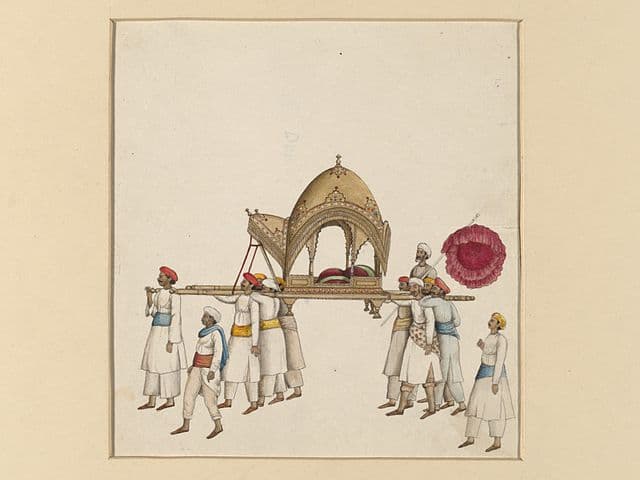The Bird Sanctuary by Sarojini Naidu
Sarojini Naidu’s poem “The Bird Sanctuary” appears in the influential collection, The Golden Treasury of Indo-Anglian Poetry (1970). This poem is about the serenity, musicality, and vibrancy of nature filled with lyrical songs of the winged fairies, birds. Its soft, mellow tune and the essence of nostalgia make this piece an interesting read. The interest does not come solely from its musicality either. It originates from the very core of Naidu’s spirit which sings like an unnoticed nightingale in the dense woods and mesmerizes hearts with its pellucid cadence. Indeed, this poem explores the unrefined magnificence of nature with eye-catching and ear-soothing imagery.
- Read the full text of “The Bird Sanctuary” below:
The Bird Sanctuary by Sarojini Naidu In your quiet garden wakes a magic tumult Of winged choristers that keep the Festival of Dawn, Blithely rise the carols in richly cadenced rapture, From lyric throats of amber, of ebony and fawn. The bulbul and the oriol, the honey-bird and shama Flit among high boughs that drip with nectar and with dew, Upon the grass the wandering gull parades its sea-washed silver, The hoopoe and the kingfisher their bronze and sapphire blue. Wild gray pigeons dreaming of a home amid the tree-tops, Fill their beaks with silken down and slender banyan twigs, But the jade-green gipsy parrots are only gay marauders, And pause upon their sun-ward flight to plunder red ripe figs. In your gracious garden there is joy and fostering freedom, Nesting place and singing space for every feathered thing, O Master of the Birds, grant sanctuary and shelter Also to a homing bird that bears a broken wing. - from The Golden Treasury of Indo-Anglian Poetry (1970)
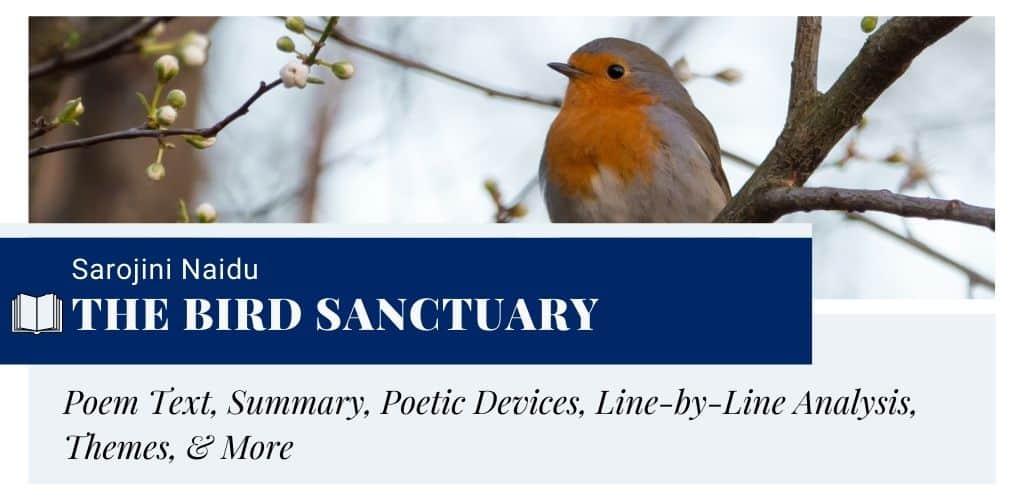
Summary
“The Bird Sanctuary” takes readers to nature’s abode, a quiet garden filled with sonorous music of birds. It is like a temple where, at dawn, choristers of nature begin the hymn to God, the almighty in unison. For Naidu’s poetic persona, not only the birds, but all the creatures sing together. In this beautiful garden, she can notice a number of birds including bulbul, oriol, honey-bird, shama, etc. She describes what they do in the garden. Furthermore, Naidu contrasts the lifestyles of gray pigeons and the gypsy parrots. Finally, she evokes the spirit of the “Master of the Birds” to give her sad soul a place in his magnanimous sanctuary.
Form, Rhyme Scheme, & Meter
Form
Naidu’s poem “The Bird Sanctuary” is a lyrical piece written in the conventional ballad stanza form. It consists of four quatrains. A quatrain is a stanza having four lines. Each stanza ends with end-stopped lines. It means each section makes complete sense. Besides, the poet speaks in this piece from a first-person speaker’s perspective. This feature alongside the musicality of the poem makes it an ideal example of a lyric.
Rhyme Scheme
As the poem is written in imitation of the ballad form, it contains the ABCB rhyme scheme. It means the second and fourth lines of each stanza rhyme together. For example, in the first stanza, the words “Dawn” and “fawn” rhyme. This scheme is followed throughout the poem. One has to read two lines at a go in order to find how the rhyming intricately conjoins the ideas.
Meter
The overall poem is written in iambic hexameter. There are a total of six iambs (an unstressed syllable followed by a stressed syllable) per line. Readers can also find a number of metrical variations across the text. These include the occasional use of anapests and spondees. Let’s have a look at the scansion of the first and the last stanzas in order to understand how the poem sounds like.
In your/ quiet gar/-den wakes/ a ma/-gic tu/-mult
Of winged/ cho-ris/-ters that keep/ the Fes/-tiv(a)l of Dawn,
Blithe/-ly rise/ the ca/-rols in rich/-ly ca/-denced rap/-ture,
From ly/-ric throats/ of am/-ber, of e/-bo-ny/ and fawn.
…
In your gra/-cious gar/-den there/ is joy/ and foster/-ing free/-dom,
Nest/-ing place/ and sing/-ing space/ for eve/-ry fea/-thered thing,
O Mas/-ter of/ the Birds,/ grant sanc/-tu-ary/ and shel/-ter
Al-so/ to a hom/-ing bird/ that bears/ a brok/-en wing.
Poetic Devices & Figurative Language
Sarojini Naidu makes use of the following poetic devices in “The Bird Sanctuary.”
- Metaphor: The first stanza is packed with metaphors that include “magic tumult/ Of winged choristers”, “Festival of Dawn”, “cadenced rupture”, and “lyric throats of amber”. In the last stanza, “Master of the Birds” is a metaphor of the almighty and the “broken wing” is a metaphor of a sad heart.
- Synecdoche: It occurs in “Flit among the high boughs that drip with nectar and with dew”. Here, Naidu refers to the “boughs” in order to depict the flowers hanging on them.
- Alliteration: The repetition of similar sounds can be found in “richly cadenced rapture”, “that drip”, “sea-washed silver”, “tree-tops”, “red ripe”, “gracious garden”, “fostering freedom”, “singing space”, etc
- Personification: In the first stanza, Naidu personifies the birds in “winged choristers”. The “amber”, “ebony”, and “fain” are also personified as having “lyric throats”. It means they also sing at the “Festival of Dawn”.
- Apostrophe: In the third line of the last stanza, “O Master of the Birds” is an example of apostrophe. Here, the speaker evokes the almighty as a master of all the birds.
- Imagery: Naidu makes use of visual imagery and auditory imagery throughout the poem. For example, “The hoopoe and the kingfisher their bronze and sapphire blue” contains visual imagery, and “Blithely rise the carol in richly cadenced rapture” contains auditory imagery. Besides, in the last line, she uses organic imagery to convey her sadness.
Themes
Naidu explores the themes of the musicality of nature, birds, comfort vs uncertainty, grief, and spiritual longing in this poem. The list does not end here. If readers dive deeper into the lines, they can pick a few more from the text. The main theme of this poem concerns the musicality of nature. To describe this theme, Naidu resorts to the song of birds at dawn. The music that is inherent to our soul, comes from the lyricism of nature. The same applies to the poet as well.
Besides, the speaker also describes the beauty of birds in this poem. She beautifully captures their movement and features. Apart from that, the third stanza contains an interesting theme. It is about the comfort of home and the carefree life of “gay marauders”. The poet compares these ideas by using the symbols of “Wild gray pigeons” and “jade-green gipsy parrots”.
The last stanza specifically explores the poet’s sadness and spiritual longing. Here, she implores God to grant him a place in the holy resort of nature. After witnessing the beauty of the garden, she becomes sad. The musicality and serenity in nature create a sense of longing in her heart.
Line-by-Line Analysis & Explanation
Lines 1-2
In your quiet garden wakes a magic tumult
Of winged choristers that keep the Festival of Dawn,
“The Bird Sanctuary” is rich in imagery and metaphors. These devices are present at the very beginning of the poem. In the first line, Naidu’s poetic persona depicts a “quiet garden”. It suddenly gets filled with an outburst of twittering and chattering of birds. The irregularity of several sounds creates a tumultuous environment at dawn. Readers can sense how the internal volume keeps rising until the end of the second line.
In the second line, “winged choristers” refers to the birds. Here, the poet compares them to choristers who sing hymns to God. In this way, the poet associates a devotional essence into the lines. The “quiet garden” turns out to be a temple where a festival is held every day at dawn.
Lines 3-4
Blithely rise the carols in richly cadenced rapture,
From lyric throats of amber, of ebony and fawn.
In the following line, the term “blithe” depicts the carefree nature of the “carol”, a metaphorical reference to the birds’ song. Though they don’t sing in unison, a beautiful composition comes out of the irregularity. The irregularities in nature also create a magnificent tune if one has the ears to sense it.
Naidu further describes the song as a “richly cadenced rapture”. It means the “richly cadenced” song of birds makes the poet’s heart ecstatic. In the choir, there are some other members including the “amber”, “ebony”, and “fawn”. They play the part of vocalists.
By the term “amber”, the poet also associates the scent of amber leaves. Ebony is a tree of tropical and warm-temperate regions. While “fawn” is a young deer. In the “Festival of Dawn”, fawns and other animals also sing the carols along with the birds and trees. It seems the whole creation starts singing in praise of the blissful dawn.
Lines 5-8
The bulbul and the oriol, the honey-bird and shama
Flit among high boughs that drip with nectar and with dew,
Upon the grass the wandering gull parades its sea-washed silver,
The hoopoe and the kingfisher their bronze and sapphire blue.
The second stanza alludes to the birds present in the garden. There are bulbul, oriole, honey-bird, and shama. Their movement among the high boughs is swift and light. It seems as if they are fairies of nature, beautifully winging across the garden trees. Naidu depicts the boughs as shedding small drops of nectar and dew. Here, the nectar of flowers and the dew on the leave’s tip are depicted. It seems the whole bough is filled with the sweetness of nectar and ornamented with pearl-like dew.
The speaker can find the gulls ostensibly displaying their plumage upon the grass. Naidu compares the color of its feathers to “sea-washed silver”. The seawater washes their feathers while they fly over it and makes the plumage look shiny. Besides, hoopoe and kingfisher are parading their bronze and sapphire blue feathers. Here, the poet use images of metals (silver and bronze) and a stone (sapphire) in order to depict the hue of the birds’ plumage.
Lines 9-12
Wild gray pigeons dreaming of a home amid the tree-tops,
Fill their beaks with silken down and slender banyan twigs,
But the jade-green gipsy parrots are only gay marauders,
And pause upon their sun-ward flight to plunder red ripe figs.
In the third stanza, Naidu presents an antithetical idea by presenting two species of birds. One is the wild pigeon. The other one is the parrot. The pigeons are dreaming of a home while they hover around the treetops. They fill their beaks with the slender and smooth twigs of banyan. Their dream keeps them motivated to do this mundane work of collecting twigs.
In contrast, the parrots do not even care for a home like the pigeons. The contentment of living at one place for the rest of their lives is suffocating. They are the “gay marauders” of nature, unanchored to the comforts of the nest. According to the poet, they only pause upon their flight directed by the sun, to plunder red figs of the garden.
Naidu compares and contrasts the conventional lifestyle with the life of a vagabond. Most of us work day and night for survival. There is also a distinct group who live just like the parrots. However, the poet does not glorify one over the other. She is of the view that we can find happiness in both courses of living.
In the phrase “jade-green gipsy parrots”, the poet uses a metaphor to compare the color of the parrots to that of the jade (kind of hard and green stones). There is an alliteration of the “g” sound in “green gipsy”. In the last line, the “sun” is a symbol of God. The poet compares herself to the parrots and describes how she is also on the way of finding spiritual fulfillment. She pauses a while to take delight in the red-ripe-fig-like beauty of nature.
Lines 13-16
In your gracious garden there is joy and fostering freedom,
Nesting place and singing space for every feathered thing,
O Master of the Birds, grant sanctuary and shelter
Also to a homing bird that bears a broken wing.
The last stanza begins as the first stanza with a reference to the lord. Naidu’s speaker hints at God’s “gracious” creation, nature, by using the metaphor of a “garden”. She describes it as a place that fills one’s heart with joy. Besides, it fosters the passion for freedom in the soul. In the cozy bosom of nature, birds make nests. They sing their melodious gratitude for the care and comfort mother nature provides.
In the third line, the poet evokes the “Master of the Birds”. It is a reference to the almighty. She implores God to grant a sanctuary and shelter to her soul. She compares her present mental state to that of a bird with a broken wing. Its “wings” symbolizes freedom. It can be an allusion to the subjugation of India.
On the other hand, the phrase “homing bird” depicts the poet’s homesickness. At the time of writing this poem, she was traveling to different regions of India. Through this line, she is projecting her sense of longing for her home as well as nature. This line can be interpreted differently by using the materials available in the text.
The speaker refers to her spiritual sickness by the phrase “broken wing”. As a bird cannot soar with a broken wing, the poet cannot get salvation with earthly emotions. Hence, she wishes for a spiritual resort in nature in order to be in everlasting bliss. In this way, she seeks to be part of the “winged choristers” and sing at the “Festival of Dawn”.
About the Birds in “The Bird Sanctuary”
Bulbul
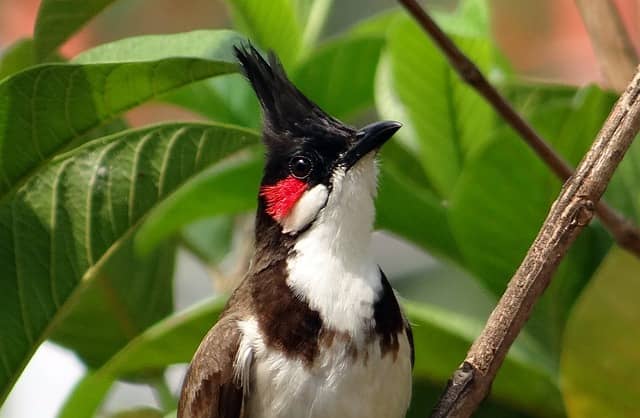
The bulbuls are medium-sized songbirds, typically found in the Middle East, tropical Asia to Indonesia, Japan. In this poem, Naidu probably refers to the red-whiskered bulbul or crested bulbul that is native to Asia. It is commonly found in hill forests and urban gardens.
Oriole
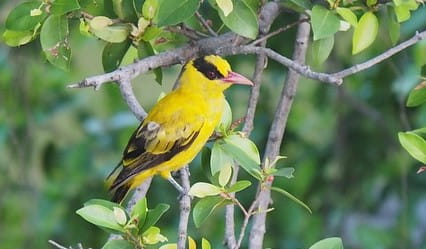
Oriole is an Old World family of passerine (perching or singing) birds. Naidu refers to a species of Oriole that is found in the Indian subcontinent and Central Asia. It is known as the Indian golden oriole. This bird lives in forests, garden orchards, and plantations.
Honeybird
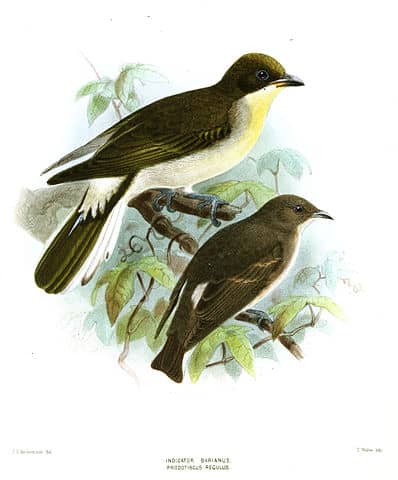
Honey birds are also known as Honeyguides. It can be found in Africa and Asia. These birds are known for interacting with humans. Some species of honey birds lead humans to bee colonies in order to eat grubs and beeswax left after the collection of honey.
Shama
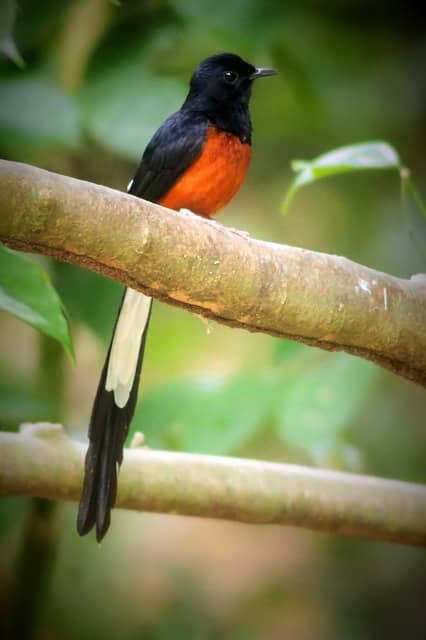
The white-rumped shama, simply known as shama, is native to the vegetation of the Indian subcontinent and Southeast Asia. The melodious voice of the shamas makes them popular as cage birds.
Gull
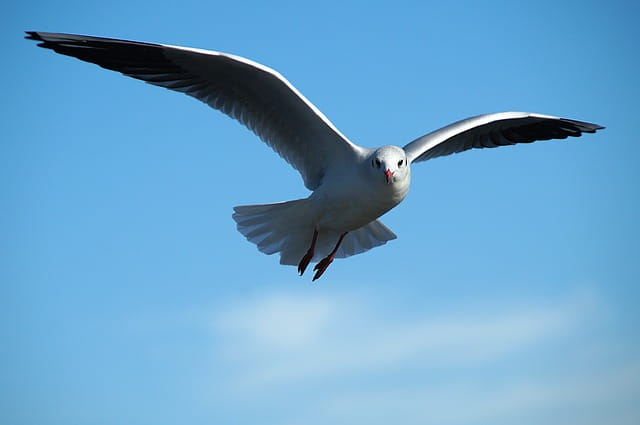
Gulls or seagulls are seabirds. They are typically medium to large birds, usually grey or white, often having black markings on the head and wings. Various species of gull are found in different regions of India. These include White-eyed Gull, Slender-billed Gull, and Pallas’s Gull.
Hoopoe
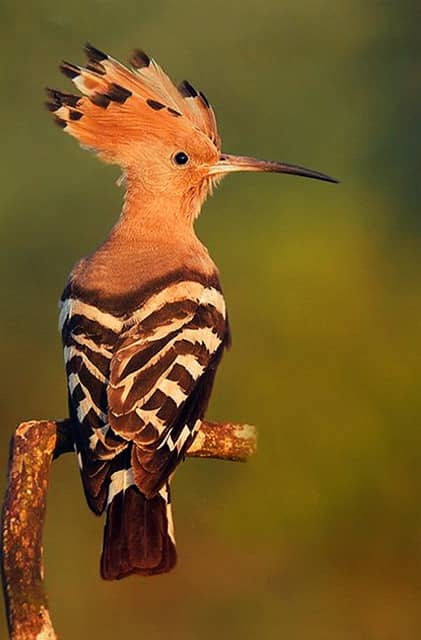
Hoopoes are notable for their “crown” of feathers and colorful plumage. They are found across Africa, Asia, and Europe. The Eurasian hoopoe species are found in India. Naidu describes its “bronze” colored plumage in the poem.
Kingfisher
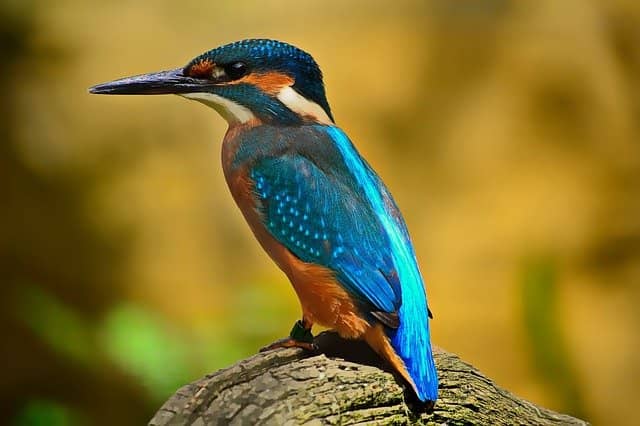
Kingfishers are brightly colored birds. The common kingfisher species are found in India. They have short tails, large heads, blue plumage, orange underparts, and long bills. In this poem, the poet describes its blue plumage by comparing it with the color of sapphire.
Wild Pigeon
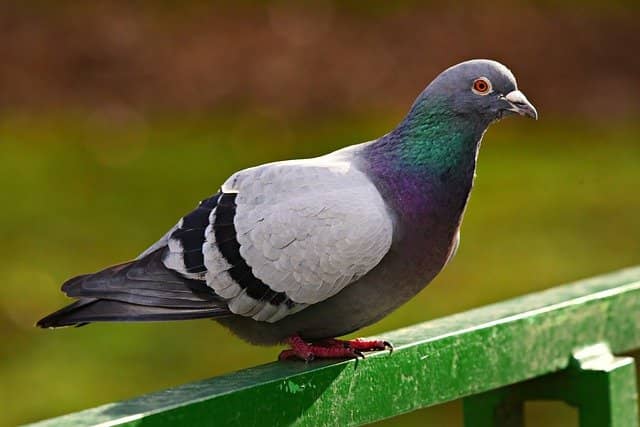
The rock pigeon or common pigeon is often simply referred to as the “pigeon”. Wild pigeons are pale grey with two black bars on each wing. They are generally found in West Asia, Europe, and North Africa.
Parrot
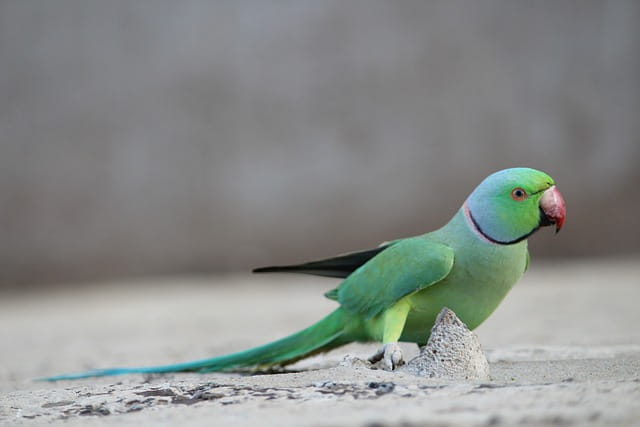
In this poem, Naidu refers to the rose-ringed parakeet or the ring-necked parakeet. It is a medium-sized parrot native to the Indian subcontinent and Africa. Both males and females can mimic human speech. The poet described its plumage as having a “jade-green” color. According to her, they are the “gay marauders” of nature.
Our Own “Homing Bird”
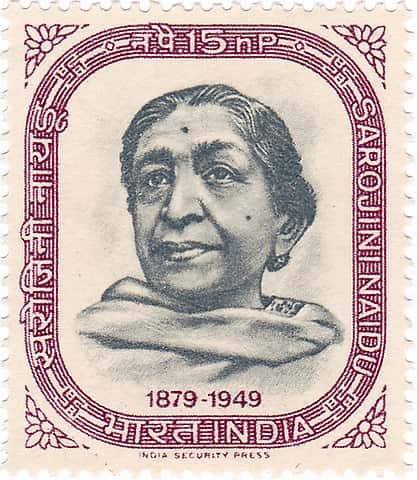
The “homing bird” is none other than the poet Sarojini Naidu herself. She describes her soul longing to return to nature as a bird whose wing is broken. Besides, she is also known as “the Nightingale of India”.
Historical Context
“The Bird Sanctuary” appears in the collection, The Golden Treasury of Indo-Anglian Poetry, 1828-1965. It was published in 1970. Between 1915 and 1918, Sarojini Naidu traveled to a number of places in India. Later, in 1917, she went to London to advocate for universal suffrage. The poem was written around this period. Naidu’s whole-hearted involvement in the Indian independence movement might have made her soul weary. Besides, the subjugation of her motherland was also a long-lasting heartache that she could not find a cure of. Only nature gave her solace during this phase. Through this poem, Naidu tried to express her longing for a spiritual resort to soothe her weary mind.
Questions and Answers
Sarojini Naidu wrote this poem around 1917 while she was involved in the Indian independence movement. She wrote this poem for two reasons. The first reason is to describe the unspeakable beauty of the birds and their melodious cacophony that can be heard at the stroke of dawn. Another reason is to portray the poet’s state of mind while writing this poem. She was weary like a bird with a broken wing. Her only wish to God is to grant her a sanctuary where she can be part of the everlasting bliss.
The title of the poem “The Bird Sanctuary” is an extended metaphor for a spiritual abode where a soul rests or finds peace in. Naidu’s paradise does not exist somewhere above the clouds or in some hilltops. It is there where the birds sing beautifully at dawn, in an unsophisticated garden of nature.
The “garden” is a metaphor for a spiritual resort. While the “birds” collectively stand for the song of nature that is ceaseless and eternal. Besides, the “homing bird” is a reference to the poet’s soul longing for spiritual satisfaction.
The “jade-green” parrots are described as “gay marauders”.
The term “marauder” literally means a raider. It is also a reference to a lawless adventurer who does not conform to the conventions of society. The parrots are called “gay marauders” as they plunder the ripe figs of the garden. Besides, parrots are hard to tame. For this reason, Naidu describes them as the happy adventures of nature.
Naidu mentions the bulbul, oriole, honey-bird, shama, gull, hoopoe, kingfisher, pigeon, and parrot in the poem.
The birds are celebrating the “Festival of Dawn” by singing “richly cadenced” carols.
The variety of birds mentioned in the poem evokes a lively picture of a garden at dawn. It seems the birds represent the soul of the garden. Their collective singing infuses life into the quiet garden.
The gulls have “sea-washed silver” plumage.
The birds of the sanctuary or garden are referred to as “winged choristers”.
The bulbul, oriole, honey-bird, and shama flit among the high boughs that drip with nectar and dew.
Sarojini Naidu earned the sobriquet “the Nightingale of India” or “Bharat Kokila” from Mahatma Gandhi. For her lyricism, use of color, and imagery Gandhi gave her the title. As the nightingale is known for its sweet, intoxicating song and cannot be found easily. Naidu is such a nightingale of India whose poetry has the ability to reach one’s soul. She is one such hidden gem that is both rare and precious.
Similar Nature Poems
- “The Vagabond” by Robert Louis Stevenson — This poem of Stevenson explores one speaker’s longing for living in the bosom of mother nature.
- “When my play was with thee” by Rabindranath Tagore — In this poem, Tagore describes his relationship with the lord.
- “A child said, What is the grass?” by Walt Whitman — This simple poem explores the mysteries of life by introspecting on nature.
- “Dawn at Puri” by Jayanta Mahapatra — Like Naidu, here Mahapatra depicts the beauty of an Indian seashore.
External Resources
- Check out of The Golden Treasury of Indo-Anglian Poetry (1828-1965) — Explore more Sarojini Naidu poems published in this book alongside the works of other Indo-Anglian poets.
- Sarojini Naidu, the Nightingale of India — Read the short biographical sketch of Naidu.
- About Sarojini Naidu — Learn about the poet’s life, her political and literary career.
- Google Doodle on Sarojini Naidu’s 135th Birthday — Explore the doodle commemorating Naidu’s 135th birth anniversary.

